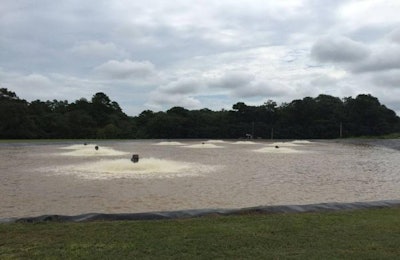
By land applying poultry wastewater, Claxton Poultry Farms converted hundreds of acres of land dominated by weeds and prickly pear cactus to productive farmland producing nutritious feed for local animal production.
Riverside Farms, developed by Claxton Poultry as a land application site for poultry wastewater, has a total area of 3,262 acres, of which 782 are permitted for wastewater irrigation. Three electrical vertical turbine pumps deliver up to 2.0 million gallons daily of treated wastewater to 12 center-pivot irrigation rigs. Hay, corn and cotton are produced on the irrigated land.
Claxton Poultry slaughters and processes 430,000 broilers per day at an average live weight of 4.7 pounds to produce an average poultry wastewater flow of 1.6 million gallons per day.
Wastewater is sprayed year-round on Bermuda grass or row-crop fields, overseeded with a cool-season annual rye grass crop during the winter.
To ensure protection of ground water resources, nitrogen balances are determined for each crop, and this guides loading rates. Monthly nitrogen loading is tracked to ensure that the nitrogen loading limit of 193 pounds per acre per quarter is not exceeded.
The land application is on deep sandy soils that require addition of nutrients and irrigation to grow crops. Wastewater constituents are assimilated by being retained in the soil, utilized by the plants and acted upon by soil organisms. This “living filter” is the final treatment process.
The irrigated water percolates to and recharges ground water, and this also provides base flow that helps maintain flow in local rivers and streams year-round.
Buffer areas along streams on the farm also serve as an important refuge for forest-dwelling wildlife that graze in the open areas of the farm. There are approximately 150 acres of food plots planted in these buffer areas to feed deer, turkey, doves and quail. Twelve ponds serve as a resting area for resident and migrating waterfowl. Larger ponds have been stockpiled with largemouth bass and other game fish. Claxton Poultry has planted approximately 200,000 pine trees since purchasing the land to act as wind breaks and to provide bedding areas for wildlife.
With the addition of a third kill line to its processing facility in 2013, Claxton Poultry placed major emphasis on capturing and diverting blood from the wastewater treatment processes. The blood is sold to a rendering facility for processing.

Claxton Poultry screens the wastewater to remove feathers from its flow.
The annual Clean Water Awards are sponsored by U.S. Poultry & Egg Association.

Claxton Poultry environmental manager, Steven Fries.
Learn more about wastewater treatment at Claxton Poultry:
Claxton Poultry makes hay with wastewater, http://video.wattagnet.com/95U
















